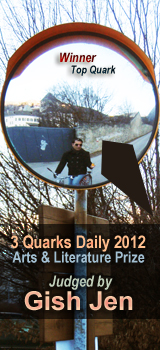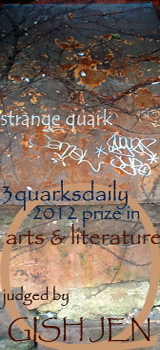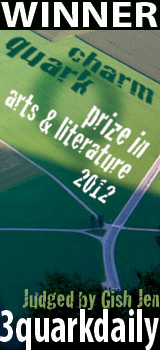


Gish Jen has picked the winners from the nine finalists:
1. Top Quark, $1000: Melissa Fisher, My First Job
2. Strange Quark, $300: Leanne Ogasawara, Leonardo in the Gilded Age
3. Charm Quark, $200: Syed Haider Shahbaz, The Last Novel
Here is what Gish had to say about them:
So difficult to choose! I took something away from every one of these wonderful pieces. Some I eliminated for entirely unfair reasons — deepest apologies especially to Lydia Kiesling whose piece on Sister Carrie married sensibility with insight and might well have won a prize this year had Kiesling not already won one last year. And apologies to the other accomplished finalists as well. There is no doubt in my mind that another judge would have chosen entirely differently than I.
In the end, I picked pieces that seemed to me 1) to be singular — that is, produced by a particular mind animated by a particular subject and 2) to possess momentum — that is, to lead onward or outward in a significant way. My choices, then, were:
For Top Quark: My First Job. This memoir of growing up in Vermont begs to be turned into a book. At once deeply universal and deeply strange, it is wonderfully unpretentious, completely appalling, and appealingly clear-of-heart.
For Strange Quark: Leonardo in the Gilded Age: The frank and passionate engagement of the writer with a painting he or she has never even seen is riveting. The comparison of the hands with the Kudara Kannon Statue, the reflections on the refraction of light in the rock crystal orb, the sudden cut to a book about a court battle involving a putative Leonardo are absorbing, delightful and inspiring. This piece both follows the writer’s idiosyncratic mind and, through its many enriching links, opens the painting out.
For Charm Quark: The Last Novel. It is hard to believe the author is an undergraduate. The summoning of a whole life, the drive to portray art and life in all their irony and complexity, and the grappling, haunted quality here all bespeak promise. I look forward to its fulfillment.
Congrats again to all the finalists, and to the semifinalists, too. So much fine writing and thinking! It’s enough to make a person think the arts are thriving as never before.
Congratulations also from 3QD to the winners (remember, you must claim the money within one month from today–just send me an email). And feel free, in fact we encourage you, to leave your acceptance speech as a comment here! And thanks to everyone who participated. Thanks also, of course, to Gish Jen for doing the final judging.
The three prize logos at the top of this post were designed by me, Sughra Raza, and Carla Goller. I hope the winners will display them with pride on their own blogs!
Details about the prize here.
